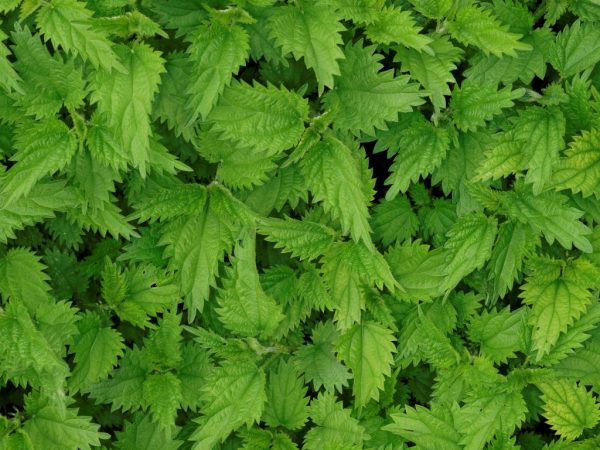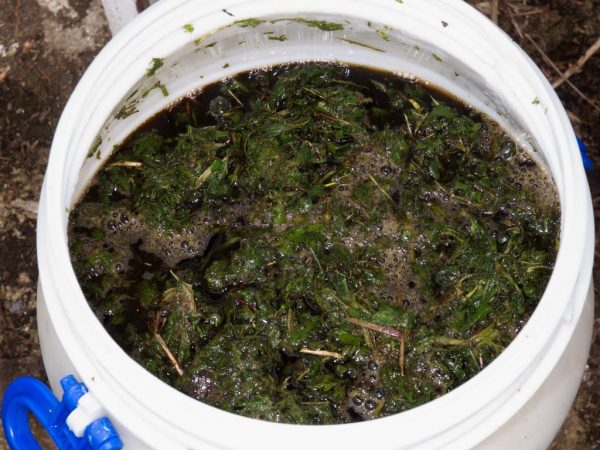What are the benefits of nettle for feeding tomatoes
Nettle for feeding tomatoes is very popular. This option is a simple and effective method of fertilization, which ensures the natural circulation of life-giving substances and microelements (what the weed takes from the soil during its growth is returned).

The benefits of nettle for feeding tomatoes
Chemical composition and benefits
To understand the benefits of this weed, you need to study the chemical composition of the plant. The main microelements that are rich in nettle tomato feed:
- Ca (calcium) - 37%. It promotes photosynthesis and metabolism. From a lack of calcium, growth stops, shoots and leaves wither.
- K (potassium) - 34%. It activates the work of enzymes, promotes the movement of beneficial trace elements, is responsible for maintaining the level of moisture. From a lack of potassium, the plant loses its strength and elasticity, then dies.
- Mg (magnesium) - 6%. It is, like calcium, necessary for photosynthesis. The absence of magnesium is determined by the appearance of the foliage: it loses color, fades.
In terms of the amount of nitrogen, this weed significantly exceeds its content in poultry, cow, horse manure. All elements are well absorbed by vegetable crops, but are especially useful for tomatoes.
There are fertilizing methods for the nightshade family such as watering, mulching, and spraying. When watering with nettle infusion, tomatoes tend to build up vegetative mass and form high-quality fruits. Mulching helps the plant to develop, performs a protective function against attack by slugs and snails. Spraying eliminates harmful microorganisms and late blight.
Collecting nettles
Before you go in search of this plant, you need to take safety measures: clothes and shoes should be covered, you should have tight gloves with you (this will help protect your body from burns). You need to prepare a knife or garden shears and a bag for collecting fertilizer.
It is best to harvest the nettles before the seeds appear. It is at this stage of maturation that the weed is rich in nutrients. Plants should not contain external damage by microorganisms or rot. Young shoots are best suited for this.
Preparation and application
Nettle fertilizer has many different recipes, which are based on fermented plant matter. Subsequently, all kinds of ingredients are added to this mass to increase a particular amount of chemical elements.
Before getting started, you need to:
- Decide on the choice of container for liquid. This can be a wooden barrel, a plastic vessel, or an enamel bucket. It is not recommended to use an iron container: when the metal comes into contact with the plant, a chemical reaction occurs, all useful trace elements disappear.
- Chop the branches and leaves of the nettle and pour into the selected container. Fill more than half the volume of the prepared container.
- Pour all this with warm water, not reaching the edges of the container. After that, the fermentation process begins and foam forms.
After about 2 weeks, when fermentation is complete, the infusion will be ready. Top dressing should be stirred daily so that the release of nutrients is evenly carried out.
Watering plants

Before use, the infusion must be diluted with water.
Before you start watering tomatoes, the fertilizer is diluted with water in a ratio of 1:10, that is, for 10 liters of water there is 1 liter of top dressing. With this infusion, tomatoes need to be fertilized once every 2 weeks. After this procedure, they need regular abundant watering.
Spraying
To spray tomatoes with infusion, you need to mix 1 part of the prepared mixture and 20 parts of water in a ratio of 1:20. This prophylaxis is carried out no more than once a month.
Mulching
Mulching - covering the soil with natural inorganic materials that provide:
- protection of soil from moisture evaporation;
- uniform feeding of tomatoes;
- weed control.
Raw nettles are dried for several days. During this time, excess moisture evaporates, the decay process does not occur. After that, the dry grass is laid out on the beds and in the aisles, while the mulch should not come into contact with the trunks of the tomatoes.
Nettle blooms from mid-May to late autumn, so it can be used to prepare the ground for tomatoes next year. A plot of the garden after harvesting is mulched with mowed nettles. This should be done when the rainy season begins. Before the onset of the first frost, the mulch has time to rot and turn into fertilizer.
Conclusion
It is believed that if tomato beds are located near the nettle planting site, this has a positive effect on the quantity and quality of the harvested crop.


